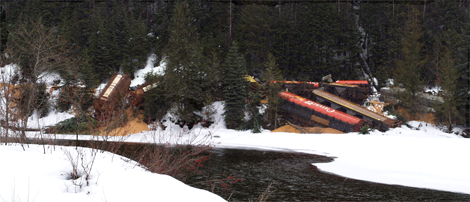
As I stand at the banks of the North Thompson River looking at the twisted wreckage of six derailed grain cars, I find myself having trouble sticking to the five Ws of good reporting. I have trouble stopping myself at the who, why, what, when, where and how of this accident. I'm stuck on 'what if?' I want to know what would have happened if those grain cars had been carrying the toxic pole oil that destroyed Wabamun Lake or any of the other toxic chemicals I see whizzing by my town everyday.
As a journalist and the editor of a small town newspaper, I have been through the five W's with Canadian National before. For a few hundred kilometres from Blue River to Valemount, and from Jasper to McBride and beyond, I have been a diligent witness to the derailments and other disasters of the Canadian National Railway.
Two nights ago, a friend with CN mentioned their most recent derailment to me at a community supper.
"Another one?" I asked.
"Two," replied my friend.
A sigh and murmur rises from the table around me. People are concerned.
Site of the wreckage
I give this account after visiting the wreckage a few miles north of Blue River (200 km north of Kamloops). On Thursday, March 2, 17 cars went off the track. Five or six cars spilled their contents on to the snowy banks of the North Thompson River. According to the company, the rail line was shutdown Friday and was running again by Saturday, though one car from another train would derail on Saturday morning.
'Thank God it was grain,' I whisper to myself when I see their contents strewn meters from open water. Later, during my interview with Jim Feeny, one of CN's communications people, he briefly asked how I managed to get to the site. It was a telling question.
On my own watch, CN's remoteness and their ownership of the rail corridor has protected them many times against the prying eyes of the media.
The CN disaster of May 2003 is a good example. One of their trains derailed some 4.5 km west of McBride, killing two employees. In spite of the company's threat to prosecute for trespassing, I was an eyewitness to the devastation. A lot of CN's property is very remote and next to impossible to get to without their cooperation.
Threat of disaster
The latest derailment in Blue River brings home the threat that CN represents to our communities again.
In August 2004, Valemount's volunteer fire department responded to a fire on a rail car carrying sulphur. The initial call was to an address within Valemount, which would have been bad for everyone, as burning sulphur emits a poisonous gas. However, after some confusion, the fire department was called with a new address just outside of the village limits. No one was injured, although some people close to the site had to be evacuated.
This incident occurred the same day that BC Parks was conducting a massive prescribed burn in nearby Mount Robson Park. At that time, CN spokesperson Graham Dallas confirmed that although CN knew about the prescribed burn and its proximity to the track (as close as 10 metres in places), they did not cease moving opened-topped sulphur cars. Dallas insisted that sulphur is not really that dangerous. That argument can be made, when it's not on fire.
People vs. robots
For me, it was this incident that brought home the message so often heard from the retired railroaders: you need people to operate these trains. You need human beings, capable of all manner of thought and observation to deal with problems that arise on a rail line.
Feeny, Dallas and the other communications officials say that automation is working just fine.
The North Thompson isn't the only river under threat. In April 2005, a major derailment occurred near Tete Jaune, a tiny community about 20 km away from Valemount. Thirty-three cars of a 151-car train derailed. One loaded car made its way into the Fraser River. Thankfully, most of the cars, including the one in the river, were carrying grain.
As I drop the narrow lens of five W reporting and reflect on my encounters with CN and their derailments, it is clear that the larger question for this company and for the people who live in my neck of the woods is not 'what if we have another catastrophic environmental disaster?' but 'when?'
Andru McCracken is editor and co-founder of the Robson Valley Times, an independent newspaper based in Valemount, BC. He can be reached at [email protected].
- Related stories:
- Number of CN derailments jumped in 2005: report
- Regulator asked to probe safety at CN Rail
- Transport Canada orders CN to shorten B.C. trains after several derailments
- Why Are We Selling Our Railway?














Tyee Commenting Guidelines
Comments that violate guidelines risk being deleted, and violations may result in a temporary or permanent user ban. Maintain the spirit of good conversation to stay in the discussion.
*Please note The Tyee is not a forum for spreading misinformation about COVID-19, denying its existence or minimizing its risk to public health.
Do:
Do not: